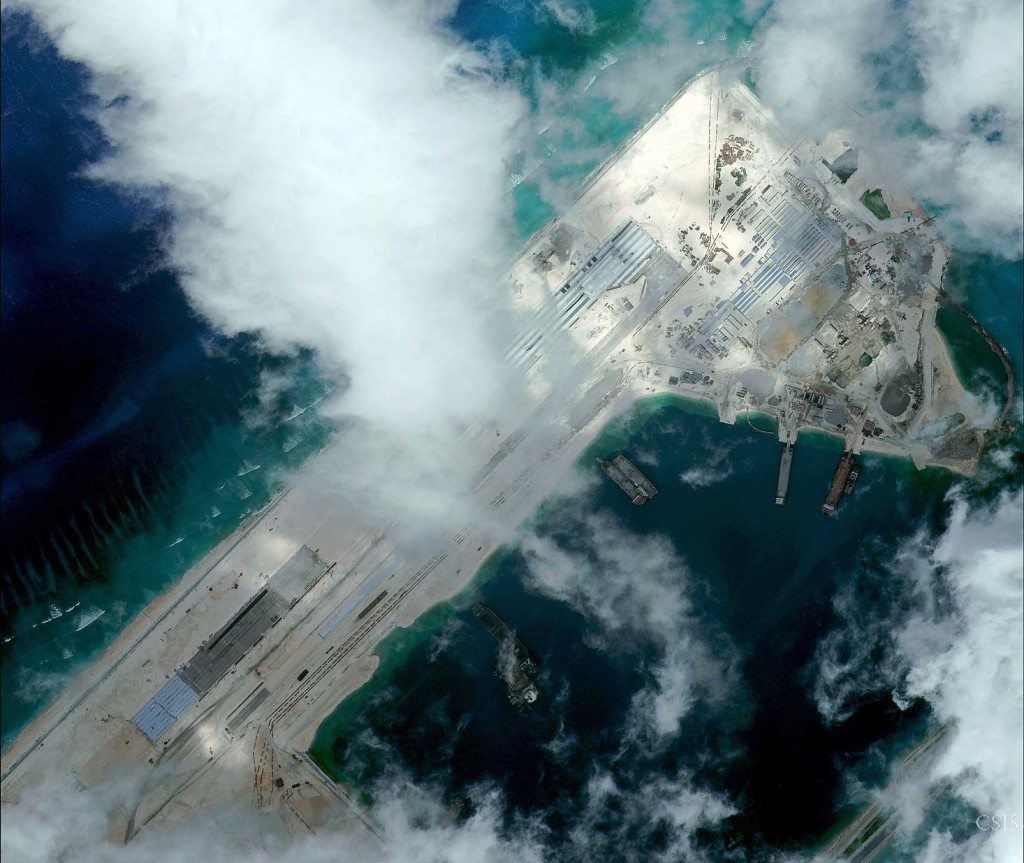By PAUL MCLEARY
 HALIFAX: By turning reefs and atolls in the disputed South China Sea into fortified artificial islands, complete with anti-aircraft Surface-to-Air Missiles, Chinahas transformed “what was a great wall of sand just three years ago [into] a great wall of SAMs,” the US commander in the Pacific said here today.
HALIFAX: By turning reefs and atolls in the disputed South China Sea into fortified artificial islands, complete with anti-aircraft Surface-to-Air Missiles, Chinahas transformed “what was a great wall of sand just three years ago [into] a great wall of SAMs,” the US commander in the Pacific said here today.
The militarization of the vital waterway for commercial shipping has been a major concern of Washington and its Asian neighbors for the past several years. But China’s increasingly aggressive challenges of American naval vessels operating in what the US and its allies consider international waters — including a near collisionof two ships in September — raises the specter of a deadly accident that might escalate into war. And if a war breaks out, the island bases become a strategic southward extension of China’s land-based defense against US ships and planes, known in the trade as Anti-Access/Area Denial (A2/AD).
As China builds more warships for its navy and continues to militarize its coast guard, Beijing has already dwarfed the fleet the United States can commit to the region, at least if you’re counting the number of hulls in the water. (Many of the Chinese ships are smaller, shorter-range coastal vessels, however). So, after the chief of Indo-Pacific Command (INDOPACOM), Adm. Philip Davidson, spoke to the annual Halifax Security Conference here, I asked him how he plans to keep up.
“We need a bigger Navy,” he said, noting how Navy leaders have repeatedly called for growing the fleet from 286 ships today to a 355-ship fleet. As the Chinese fleet continues to grow, he told me, “the capacity concern is going to become a greater concern in years to come.”
Adm. Phil Davidson
Aegis Ashore
 One way to free up more ships to counter China across the Pacific, Navy leadership says, is to shift the ballistic missile defense mission from Aegis cruisers and destroyers at sea to Aegis Ashore batteries and other systems on land. That’s something both the current Chief of Naval Operations, Adm. John Richardson , and his predecessor, Adm. Jonathan Greenert, have advocated for years.
One way to free up more ships to counter China across the Pacific, Navy leadership says, is to shift the ballistic missile defense mission from Aegis cruisers and destroyers at sea to Aegis Ashore batteries and other systems on land. That’s something both the current Chief of Naval Operations, Adm. John Richardson , and his predecessor, Adm. Jonathan Greenert, have advocated for years.
(It’s also taking a page from the Chinese playbook of emplacing long-range missile batteries on islands, even if you have to build the island first. China’s extensive arsenal of land-based missiles was one of the major factors driving the Trump Administration to withdraw from the 1987 INF Treaty with Russia so the US could build its own).
Davidson said his boss “wants to restore maneuverability back to the Navy” by shifting ballistic missile defense onshore. That would the Aegis cruisers and destroyers load their multi-purpose Vertical Launch Systems with other kinds of missiles — say, Tomahawk cruise missiles or LRASM anti-ship missiles, instead of a preponderance of SM-3 anti-ballistic missile interceptors — and range freely across the vast Pacific, instead of plowing the waves back and forth near the cities they’re protecting.
Tomorrow’s radars will be faster, smarter, connected and capable of performing multiple missions simultaneously. Learn how our engineers and facilities are making it possible.
The Aegis system was originally created to defend the fleet against large-scale Soviet air and missile attack: The rise of the Chinese military has brought this threat back to life, so the Nay wants to get its Aegis ships back to their original mission. “Those systems still have plenty of utility at sea defending against anti-ship ballistic missiles in the future, [including] ballistic missiles in space,” Davidson said. “We’ll need that against future threats that will threaten sea-based forces.”
Japan has already agreed to buy two Aegis Ashore systems, which will provide “essentially national missile defense for Japan,” Davidson said.
An Aegis Ashore command center, as shown here, is essentially an Aegis warship’s bridge transplanted to land.
Earlier this year, Japan issued a $2 billion request for two ground-based Aegis Ashore radar missile tracking stations built by Lockheed Martin. The Japanese navy already operates the ship-borne version of the system, while Romania and Poland are the only other countries to have built the ground-based system.
According to current plans, the Aegis Ashore units won’t be operational until 2025. When active, they will be able to link up with the ship-based systems to provide a deeper defense against North Korean missiles.
A wide range of counter-drone technologies comes of age.
While China is building new ships, aircraft carriers and submarines at breakneck pace — last year, the Chinese navy became the world’s largest — Davidson also has his eye on Russian moves in the region.
“While most of Russia’s malign activity occurs in other areas of the world, Russia is indeed increasingly active in the Pacific and it often seeks to block and disrupt the diplomatic efforts of others” in the region, he said, noting that Moscow has deployed three of its newest ballistic missile submarines to the Pacific over the past several years.
Russian capabilities in the Pacific are relatively modest, however, and Moscow has no plans to try to challenge the US or China for dominance of the seas in the region.
No comments:
Post a Comment